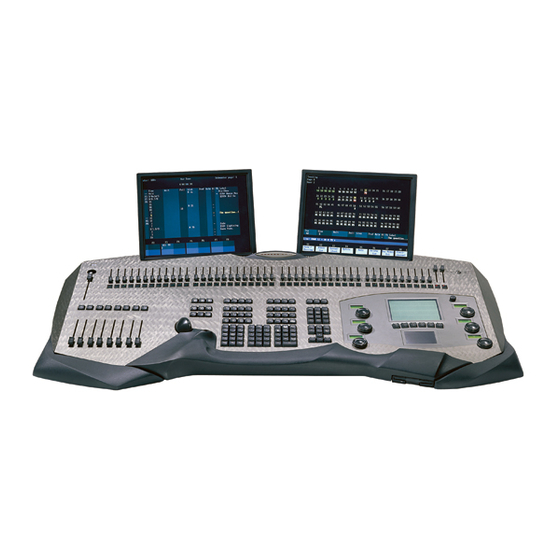
ETC Obsession II Lighting Console Manuals
Manuals and User Guides for ETC Obsession II Lighting Console. We have 2 ETC Obsession II Lighting Console manuals available for free PDF download: User Manual, Installation Instructions
ETC Obsession II User Manual (410 pages)
Brand: ETC
|
Category: Control Systems
|
Size: 5 MB
Table of Contents
-
-
New Features17
-
Help17
-
Diagnostics22
-
-
[Expand]29
-
[Swap]29
-
-
User29
-
Flexichannel29
-
Cue Line30
-
Command Line31
-
Softkeys31
-
Colors32
-
ML Displays43
-
Preview/View45
-
Flexichannel48
-
-
Cue List52
-
Group List56
-
-
-
-
Show Name59
-
-
-
Dimmer Check72
-
Flash Dimmer72
-
About Dimmer73
-
-
Special Keys81
-
-
-
-
Encoders101
-
Trackpad102
-
Touchscreen102
-
-
-
Accelerations104
-
Auto Setup104
-
Lists111
-
Library List111
-
Attribute List112
-
Fixture List112
-
-
ML Frame Tables113
-
Editing a Frame116
-
Copying a Table117
-
Labeling a Table117
-
-
-
Sneak Attributes130
-
-
Scroller Patch136
-
Chapter 11 Cues
151-
Recording Cues152
-
Labeling Cues174
-
About Cue174
-
-
-
Faders191
-
Physical Faders191
-
Virtual Faders191
-
-
-
Rate Override194
-
Manual Override195
-
-
-
-
Modifying Groups203
-
Labeling Groups206
-
Deleting Groups206
-
Copying Groups207
-
Group List211
-
-
Submaster Types213
-
Change Type213
-
Submaster Pages214
-
Submaster Leds214
-
-
Loading Cues224
-
Loading Groups225
-
Loading Effects225
-
-
Submaster List229
-
-
-
Steps231
-
-
Attributes234
-
Precedence236
-
Timing236
-
-
Modify Effects239
-
Insert Steps239
-
Delete Steps239
-
-
Label Effects242
-
Delete Effects242
-
Copy Effects243
-
The Effect List243
-
-
-
Create Macros245
-
Use Learn246
-
Next Macro247
-
Macro Wait247
-
Hold for Input248
-
Link Macros249
-
-
Play Macros250
-
Cancel a Macro251
-
-
Copy Macros251
-
Modify Macros251
-
Clear Macros252
-
Sample Macros252
-
-
-
List of Profiles255
-
Profile Display256
-
Clear to End258
-
Clear All258
-
Fill between259
-
-
Chapter 20 Park
261 -
-
-
Reset System285
-
-
Phantom Mode292
-
Slider Controls292
-
Deleting Devices294
-
Mirror294
-
Multicue296
-
-
Adding Channels298
-
Adding Fixtures299
-
-
Learning a Macro300
-
Security Log-In300
-
-
-
Record Loads309
-
Check Loads310
-
Clear Loads311
-
-
Dimmer Status313
-
System Status315
-
Error Messages317
-
Chapter 28 SMPTE
321-
-
In Learn Mode325
-
SMPTE Loop Times326
-
Editing Events329
-
-
Run Mode329
-
Pause Mode330
-
-
-
-
Facepanel Mode334
-
Show Translator339
-
-
-
-
DMX Switcher349
-
Console350
-
Hardware Setup351
-
-
Jumpers362
-
DIP Switches362
-
-
Installing MIDI368
-
Installing SMPTE368
-
-
Etclink Errors378
-
Critical Errors378
-
Secondary Errors378
-
-
-
Electrical391
-
System Capacity391
-
Keypad Controls392
-
Encoder Controls392
-
Channel Features393
-
Dimmer Controls393
-
Cue Features394
-
Group Features394
-
Effects Features395
-
Macro Features395
-
Options396
-
Size and Weight396
-
Limited Warranty397
-
Index399
-
Advertisement
ETC Obsession II Installation Instructions (3 pages)
Lighting Control Systems (all models)
Brand: ETC
|
Category: Control Systems
|
Size: 0 MB
Table of Contents
Advertisement

